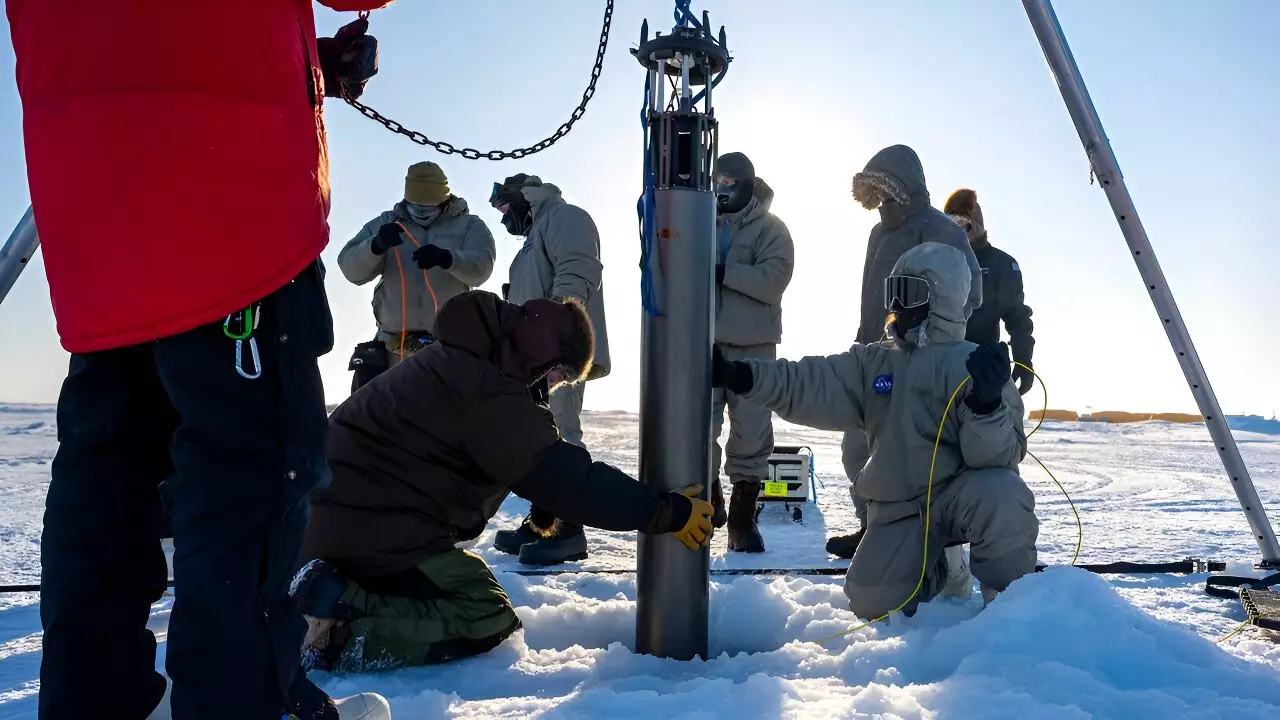As climate change accelerates, our understanding of its effects on polar ice sheets becomes crucial. The study of how Antarctic and Arctic environments are losing ice, and the consequent rise in global sea levels, is a pressing scientific endeavor. Taking a proactive approach to this challenge is NASA’s Jet Propulsion Laboratory (JPL), which has initiated the IceNode project. This ambitious initiative involves developing autonomous robots designed to penetrate the dense sea ice in extreme polar regions, directly measuring melt rates at the ice-ocean interface.
During a recent expedition in the treacherous Beaufort Sea, the IceNode team deployed a prototype robotic vehicle to ascertain the viability of their technology under harsh Arctic conditions. The robots, which measure approximately 8 feet in length and 10 inches in diameter, are engineered for rugged aquatic navigation. They do not rely on traditional propulsion methods but are equipped with sophisticated software to leverage existing ocean currents for movement. This innovative approach reflects a significant leap in how robotic technology can be utilized for scientific exploration in remote and unforgiving regions of the planet.
The excursion into these icy depths was more than mere experimental validation—it was an essential stepping stone toward understanding the global implications of ice shelf dynamics. A single complete melt of Antarctica’s ice sheet could potentially elevate global sea levels by up to 200 feet, thereby affecting millions of communities worldwide. Thus, scientific inquiries focused on this subject can vastly enhance our predictive models regarding climate change and its multifaceted impacts.
One of the project’s key objectives is to investigate the “grounding zone,” the interface where ice shelves, the ocean, and land converge. This zone is particularly important because it is where ice loss occurs rapidly due to warming ocean currents. Traditional methods of measurement—satellite imagery and surface observations—fail to provide the nuanced data needed to understand the complexities at these depths. The IceNode initiative aims to fill this knowledge gap by employing robots that can gather real-time metrics on salinity, temperature, and water flow directly beneath the ice, thus revealing critical melting characteristics that had previously remained elusive.
Researchers recognize the need for precise melt rate data, especially concerning how warm, saline water interacts with colder freshwater melt. The IceNode robots are designed to detach from their tether after reaching their destination, allowing them to ascend and attach to the underside of the ice. This unique design affords scientists an unprecedented view of the varying conditions at the ice-ocean melting interface, yielding a valuable dataset that could redefine our understanding of ice dynamics in a warming world.
Field testing within the IceNode framework has been both harrowing and enlightening. During the March 2024 configuration tests in the Beaufort Sea, the team faced unrelenting temperatures plummeting to minus 50 degrees Fahrenheit. Such conditions posed a substantial challenge to both human operators and robotic equipment alike. Conducting tests through the U.S. Navy Arctic Submarine Laboratory’s Ice Camp allowed engineers to not only operate their prototype but also to refine and adjust their technologies in real-time.
Gathering data at depths of approximately 330 feet into the ocean provided a wealth of information, thrusting IceNode into the forefront of polar robotics. This meticulous approach marks a significant advance in understanding the complexities of ice dynamics, which could prove foundational for future climate models. As the IceNode initiative develops further prototypes and conducts additional trials, hopes are high that these robots will be fully deployed under Antarctic ice shelves, offering unprecedented data crucial for scientists engaging with one of the most pressing climate issues of our time.
The IceNode project stands at the intersection of science, technology, and environmental stewardship. Not only does it embody the spirit of innovation in addressing crucial global challenges, but it also highlights the commitment to understanding climate science in greater detail. As engineers and scientists collaborate, the potential to accumulate fresh insights into ice melting rates and patterns becomes increasingly plausible.
JPL’s IceNode project serves as a beacon of ingenuity and hope amid the daunting challenges posed by climate change. By deploying autonomous robots to the Arctic and Antarctic regions, researchers are poised to gather invaluable data that could reshape projections of global sea-level rise and inform future environmental policies. As the climate crisis unfolds, the insights gained from IceNode may very well illuminate pathways to a sustainable future on our planet.


Leave a Reply